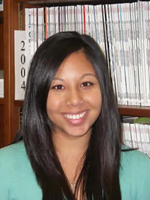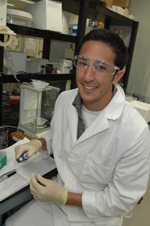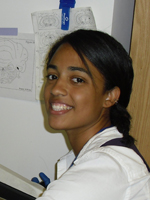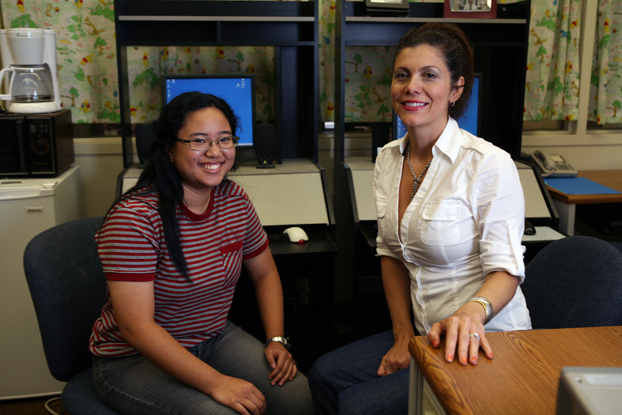 Caption: This summer, MARC scholar Reinalyn Echon is working in the lab of Iris Blandon-Gitlin, assistant professor of psychology, on a study into improving lie detection through challenges that might trigger physiological clues that someone is lying. Photo by Greg AndersenDownload Photo
Caption: This summer, MARC scholar Reinalyn Echon is working in the lab of Iris Blandon-Gitlin, assistant professor of psychology, on a study into improving lie detection through challenges that might trigger physiological clues that someone is lying. Photo by Greg AndersenDownload Photo
University STEM Initiative
Seeking Futures in Research
MARC Scholars Gain Knowledge and Practical Experience
Christina Adams hopes to one day enter a biomedical-related doctoral program — something that she didn’t even consider when she first entered Cal State Fullerton.
But thanks to the university’s Minority Access to Research Careers, or MARC, Program, it’s a goal for the junior biochemistry major.
Adams is currently in Argentina conducting research involving integrons, a mobile DNA element, and their relationship to antibiotic resistance in certain bacteria through another campus program, Minority Health International Research Training.
“Acceptance into the MARC program has given me the opportunity to ready myself for a Ph.D. program. I am grateful to be a part of a program that will provide all the necessary training I will need in order to reach my goals,” said the Buena Park resident. “The MHIRT program also is an excellent way to prepare oneself for a future in science. It is a great experience for any young aspiring scientist."
When Adams returns to Southern California, she will return to the lab of Chandra Srinivasan, associate professor of chemistry and biochemistry, where she is studying the use of the roundworm, C. elegans, as a model system in the study of antibiotic resistance in bacteria.
She is one of six new MARC Scholars spending the summer conducting experiments in mathematics, psychology and chemistry and biochemistry.
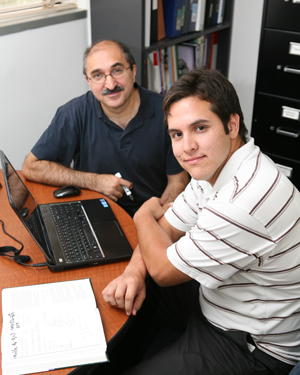 Caption: Brayan Ortiz meets with Mortaza Jamshidian, professor of mathematics, to discuss his statistical analysis and modeling of multiple sclerosis. The MARC scholar hopes to eventually earn a doctorate in biostatistics. Photo by Greg AndersenDownload Photo
Caption: Brayan Ortiz meets with Mortaza Jamshidian, professor of mathematics, to discuss his statistical analysis and modeling of multiple sclerosis. The MARC scholar hopes to eventually earn a doctorate in biostatistics. Photo by Greg AndersenDownload Photo
Students in the MARC Program are exposed to various types of research and the skills necessary to enter and succeed in graduate programs. They are required to complete specific science courses, conduct an average of 15 hours of research per week during both semesters of the academic year, perform research full time one summer on campus and one at a doctorate-granting institution, conduct a specific research project that culminates in a senior thesis, and defend their findings before a thesis committee at the end of the program.
MARC scholars attend a weekly seminar where they read scientific papers, learn how to develop research presentations and hear from guest speakers. They also are expected to attend and deliver presentations at local and national professional meetings.
“MARC scholars must perform real research under strict scientific standards, and they must present their work to other scientists the same way,” said Amybeth Cohen, MARC director and professor of biological science. “They are mentored by two-dozen-plus enthusiastic faculty in the departments of anthropology, biological science, mathematics, chemistry and biochemistry, computer science, engineering and psychology. When they finish their two years in MARC, they are scientists ready for graduate school.”
Another new scholar is Jessica Morgan of Brea, a junior biochemistry major who became interested in science while attending a physiology class at Fullerton College. “I was planning a career as a nurse but the class sparked my curiosity into how life works on the smallest of scales,” said Morgan. “I have been hooked ever since!”
Morgan is working in the lab with Maria Linder, professor of chemistry and biochemistry. She is using rat hepatoma, or cancerous liver, cells to study the process by which the body moves iron across the lysosmal membrane. She plans to attend graduate school, earn her doctorate and conduct research in either an industrial or academic setting.
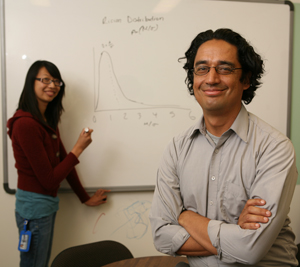 Caption: Jorly Chatouphonexay, left, a junior majoring in mathematics, is studying whether MRIs are better for diagnosing liver disease than the usual biopsy as a MARC Scholar. Pictured with her is her faculty mentor, Angel Pineda, assistant professor of mathematics. Photo by Greg AndersenDownload Photo
Caption: Jorly Chatouphonexay, left, a junior majoring in mathematics, is studying whether MRIs are better for diagnosing liver disease than the usual biopsy as a MARC Scholar. Pictured with her is her faculty mentor, Angel Pineda, assistant professor of mathematics. Photo by Greg AndersenDownload Photo
Adams and Morgan are part of a cadre of more than 50 undergraduates who have taken part in the MARC program since its inception 15 years ago. Its graduates have gone on to advanced-degree programs or positions in industry or teaching, thanks to the program, which is just one example of Cal State Fullerton’s heightened emphasis on increasing student interest in the STEM fields and a universitywide initiative.
MARC’s efforts have been funded for 16 years by the National Institutes of Health, including a just received $311,012 award for the 2011-12 academic year.
Other members of this year’s class of MARC Scholars are:
Jorly Chatouphonexay of Stanton, a junior majoring in mathematics, is studying MRIs of the human liver under the direction of Angel Pineda, assistant professor of mathematics. Chatouphonexay's research is delving into whether MRIs are better for diagnosing liver disease than the usual biopsy, said the MARC Scholar who hopes to eventually earn a doctorate in applied mathematics.
Reinalyn Echon of Walnut, is a senior psychology major who entered college considering a career in nursing. An interest in science, especially research, led to the MARC program. Echon, who is working with Iris Blandon-Gitlin, assistant professor of psychology, is delving into the area of improving lie detection through challenges that might trigger physiological clues that someone is lying.
Brayan Ortiz of Anaheim, a junior studying mathematics, is conducting statistical analysis and modeling of multiple sclerosis data “with the aim of discovering a relationship between cognition and the disease.” Ortiz, who is working with Mortaza Jamshidian, professor of mathematics, wants to eventually earn a doctorate in biostatistics. “Ultimately, I wish to work within the research for systematic lupus erythematosus. The skills that I am developing at this stage will indeed help me to contribute to further advances in treatment and, hopefully, for a cure.”
Eric Starr of Claremont, a senior majoring in psychology, is working with Jennifer Trevitt-Carlson, associate professor of psychology, exploring the role of dopamine and adenosine on decision making. Starr is currently participating in a summer research program at the University of Toledo in Ohio; he returns to campus in August.
Continuing in the two-year program are:
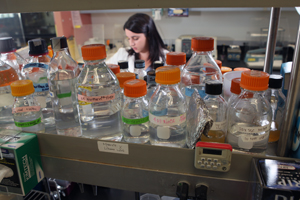 Caption: Macarena Aloi in the lab. Photo by Karen Tapia
Caption: Macarena Aloi in the lab. Photo by Karen Tapia
Macarena Aloi of Rancho Santa Margarita, a senior biological science major researching the photosynthetic organism Chlamydomonas under the direction of Amybeth Cohen, professor of biological science. Aloi is investigating whether a yet-to-be identified evolutionary significant red-light photoreceptor exists in the unicellular photosynthetic alga, Chlamydomonas reinhardtii, a direct ancestor of land plants. She is currently participating in the Summer Research Experience for Undergraduates program in the laboratory of Patricia Maness, professor of biochemistry and biophysics, at the University of North Carolina-Chapel Hill.
Erin Steelman of Mission Viejo is a senior psychology major working with Iris Blandon-Gitlin, assistant professor of psychology, to determine the hormone oxytocin’s role in accurately recognizing faces. This summer, he is taking part in the Mentoring Summer Research Internship Program at UC Riverside under the direction of Prudence Talbot, professor of cell biology.
July 26, 2011
